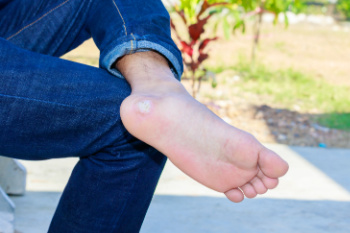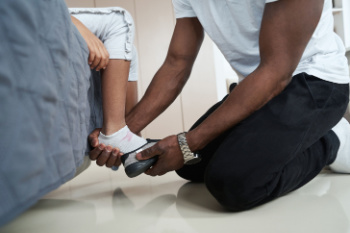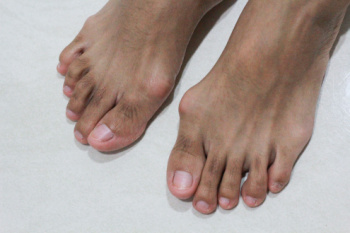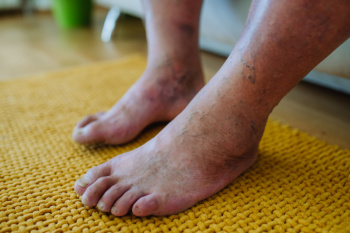Items filtered by date: February 2025
What to Know About Plantar Warts

Plantar warts, or verrucas, are common viral skin growths caused by the human papillomavirus, or HPV. They often appear on the soles of the feet, especially in children, athletes, and those with weakened immune systems. The virus thrives in warm, moist environments like near pools, and in locker rooms and communal showers, spreading through direct contact. These warts may look like thick, rough calluses with tiny black dots, which are clotted blood vessels and can cause pain when walking. Over time, they may spread or cluster into mosaic warts. Stubborn plantar warts can persist. If you or your child has a plantar wart, it is suggested that you see a podiatrist who can provide prescription medications, laser therapy, or minor surgical removal.
Plantar warts can be very uncomfortable. If you need your feet checked, contact Robert Dunne, DPM from Lake Washington Foot and Ankle Center. Our doctor will assist you with all of your foot and ankle needs.
About Plantar Warts
Plantar warts are the result of HPV, or human papillomavirus, getting into open wounds on the feet. They are mostly found on the heels or balls of the feet.
While plantar warts are generally harmless, those experiencing excessive pain or those suffering from diabetes or a compromised immune system require immediate medical care. Plantar warts are easily diagnosed, usually through scraping off a bit of rough skin or by getting a biopsy.
Symptoms
- Lesions on the bottom of your feet, usually rough and grainy
- Hard or thick callused spots
- Wart seeds, which are small clotted blood vessels that look like little black spots
- Pain, discomfort, or tenderness of your feet when walking or standing
Treatment
- Freezing
- Electric tool removal
- Laser Treatment
- Topical Creams (prescription only)
- Over-the-counter medications
To help prevent developing plantar warts, avoid walking barefoot over abrasive surfaces that can cause cuts or wounds for HPV to get into. Avoiding direct contact with other warts, as well as not picking or rubbing existing warts, can help prevent the further spread of plantar warts. However, if you think you have developed plantar warts, speak to your podiatrist. He or she can diagnose the warts on your feet and recommend the appropriate treatment options.
If you have any questions, please feel free to contact our offices located in Melbourne and Palm Bay, FL . We offer the newest diagnostic and treatment technologies for all your foot care needs.
How to Properly Fit Shoes

Fitting shoes correctly is essential for comfort and foot health. Shoes should fit snugly around the heel and midfoot without causing pressure or rubbing. The toe box should offer enough room for the toes to move freely without feeling cramped. While trying on shoes, it is important to ensure that the toes do not touch the end of the shoe, as this can cause discomfort and may gradually lead to foot problems. Ideally, there should be about a half-inch of space between the longest toe and the shoe’s front. The concept of breaking in shoes is real but limited. While new shoes may feel stiff at first, they should not cause persistent pain. If shoes are excessively tight, they are likely too small. It is important to try shoes on later in the day when the feet are slightly swollen to ensure they will remain comfortable throughout daily activities. If you have developed foot conditions from wearing shoes that do not fit correctly, it is suggested that you consult a podiatrist who can treat various foot ailments, and guide you on specifics for proper shoe fitting.
Finding a properly-fitting shoe is important in reducing injuries and preventing foot problems. For more information about treatment, contact Robert Dunne, DPM from Lake Washington Foot and Ankle Center. Our doctor will treat your foot and ankle needs.
Proper Shoe Fitting
A common concern when it comes to foot health, having properly fitted shoes can help prevent injuries to the foot. Out feet affect our posture and gait, which in turn affects the biomechanics and overall bodily structure. With 33 joints, 26 bones, and over 100 ligaments, the potential for serious injury is much greater than one realizes. Although the feet cease growth in adulthood, they still change shape as they mature. Here are some factors to consider when it comes to investing in proper fitting shoes:
- Be sure the shoes fit correctly right away
- Ensure the ball of your foot fits comfortably in the widest portion of the shoes
- Even though they may look fashionable, improper fitting shoes can either create adverse conditions or exacerbate existing ones you may already have
- Walk along a carpeted surface to ensure the shoes comfortably fit during normal activity
Keeping in mind how shoes fit the biomechanics of your body, properly-fitting shoes are vitally important. Fortunately, it is not difficult to acquire footwear that fits correctly. Be sure to wear shoes that support the overall structure of your body. Do your feet a favor and invest in several pairs of well-fitted shoes today.
If you have any questions, please feel free to contact our offices located in Melbourne and Palm Bay, FL . We offer the newest diagnostic and treatment technologies for all your foot care needs.
Symptoms and Treatment of Bunions

A bunion is a bony enlargement that develops at the base of the big toe, often caused when the top of the toe angles toward the others. This misalignment can lead to pain, swelling, redness, and difficulty walking. Other symptoms include irritated skin over the bump or stiffness in the joint. Bunions can develop due to genetics, foot structure, or wearing shoes like high heels that squeeze the toes or shift weight toward the forefoot. Bunions are diagnosed through physical examination, questions about symptoms and footwear, and sometimes X-rays to assess the joint’s alignment. Treatment focuses on reducing discomfort and improving foot function. A podiatrist can recommend footwear that minimizes pressure, as well as prescribe orthotic devices like splints or pads to improve alignment and provide cushioning. In more severe cases, this foot doctor may discuss surgery to restore joint alignment. If you have a problematic bunion, it is suggested that you schedule an appointment with a podiatrist for a diagnosis and treatment options.
If you are suffering from bunions, contact Robert Dunne, DPM of Lake Washington Foot and Ankle Center. Our doctor can provide the care you need to keep you pain-free and on your feet.
What Is a Bunion?
A bunion is formed of swollen tissue or an enlargement of boney growth, usually located at the base joint of the toe that connects to the foot. The swelling occurs due to the bones in the big toe shifting inward, which impacts the other toes of the foot. This causes the area around the base of the big toe to become inflamed and painful.
Why Do Bunions Form?
Genetics – Susceptibility to bunions are often hereditary
Stress on the feet – Poorly fitted and uncomfortable footwear that places stress on feet, such as heels, can worsen existing bunions
How Are Bunions Diagnosed?
Doctors often perform two tests – blood tests and x-rays – when trying to diagnose bunions, especially in the early stages of development. Blood tests help determine if the foot pain is being caused by something else, such as arthritis, while x-rays provide a clear picture of your bone structure to your doctor.
How Are Bunions Treated?
- Refrain from wearing heels or similar shoes that cause discomfort
- Select wider shoes that can provide more comfort and reduce pain
- Anti-inflammatory and pain management drugs
- Orthotics or foot inserts
- Surgery
If you have any questions, please feel free to contact our offices located in Melbourne and Palm Bay, FL . We offer the newest diagnostic and treatment technologies for all your foot care needs.
Foot-Related Complications From Diabetes

Diabetes can cause serious complications in the feet, toes, and ankles, especially if blood sugar levels are not well managed. Nerve damage, known as diabetic neuropathy, can lead to numbness or tingling, making it harder to notice injuries like cuts or blisters. Poor circulation, another common issue, reduces the blood flow to the lower limbs needed for healing, increasing the risk of ulcers or infections. Foot deformities, such as claw toes or changes in the arches, can create pressure points that increase the likelihood of injury. Without proper care, complications like deep infections or even gangrene may develop, sometimes resulting in limb loss if ignored. Regular foot exams and early detection of foot problems are vital for preventing these outcomes. A podiatrist can help by monitoring blood flow, nerve function, and skin health, as well as addressing issues such as ulcers, deformities, or poor footwear choices. If you have foot problems resulting from diabetes, it is suggested that you schedule regular appointments with a podiatrist who can to help manage them.
Diabetic foot care is important in preventing foot ailments such as ulcers. If you are suffering from diabetes or have any other concerns about your feet, contact Robert Dunne, DPM from Lake Washington Foot and Ankle Center. Our doctor can provide the care you need to keep you pain-free and on your feet.
Diabetic Foot Care
Diabetes affects millions of people every year. The condition can damage blood vessels in many parts of the body, especially the feet. Because of this, taking care of your feet is essential if you have diabetes, and having a podiatrist help monitor your foot health is highly recommended.
The Importance of Caring for Your Feet
- Routinely inspect your feet for bruises or sores.
- Wear socks that fit your feet comfortably.
- Wear comfortable shoes that provide adequate support.
Patients with diabetes should have their doctor monitor their blood levels, as blood sugar levels play such a huge role in diabetic care. Monitoring these levels on a regular basis is highly advised.
It is always best to inform your healthcare professional of any concerns you may have regarding your feet, especially for diabetic patients. Early treatment and routine foot examinations are keys to maintaining proper health, especially because severe complications can arise if proper treatment is not applied.
If you have any questions, please feel free to contact our offices located in Melbourne and Palm Bay, FL . We offer the newest diagnostic and treatment technologies for all your foot care needs.
